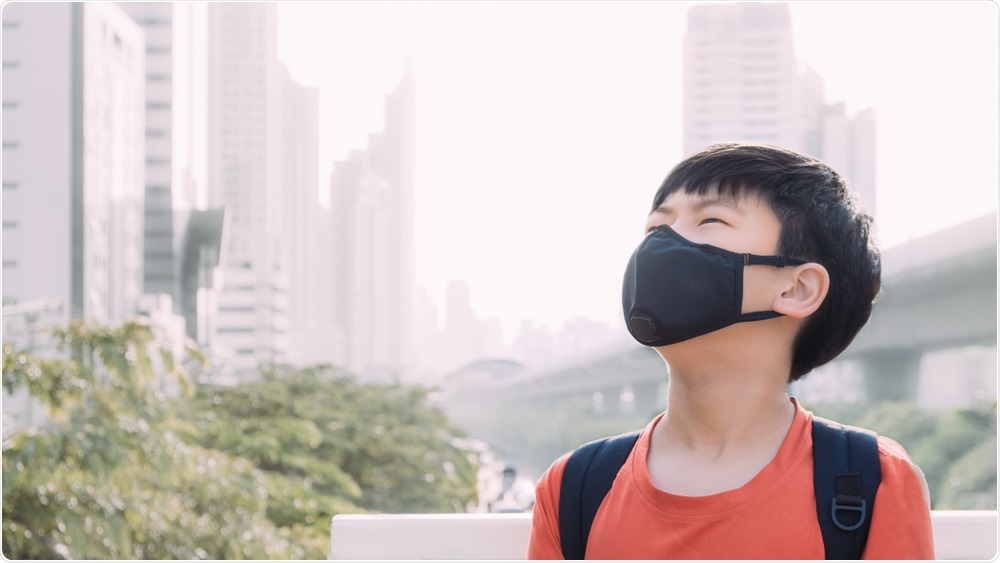Even as governments across the United States consider lifting mask mandates and relaxing preventative measures as vaccination numbers creep up, new research from a UCLA-led team has found that such basic techniques significantly reduce the risk of getting COVID-19.

Poor Air Quality. Image Credit: myboys.me/Shutterstock.com
In addition, the research found that U.S. counties with higher exposures to poor air quality, historically, saw higher county-level COVID-19 mortality rates in 2020, with a 7.6% increase in COVID-19 risk with a one-unit increase of 2.5 micrometers (µm), or PM2.5. The use of preventative measures – like stay home orders and masking – reduced the risk of COVID-19 by 15% and 8%, respectively, but did not reduce the increase of incidence in counties with poor air quality.
This is evidence that long-term exposure to poor air quality increased the risk of COVID-19, during each surge, and cumulatively, in the United States. And although both state-level implementation of facemasks mandates and stay home orders were effective in preventing the spread of COVID-19, no clear effects were observed in terms of long-term exposure to fine particulate matter."
Dr. Zuo-Feng Zhang, UCLA Fielding School of Public Health (FSPH) distinguished professor of epidemiology and associate dean for research
The research – "Long-Term Exposure to PM2.5, Facemask Mandates, Stay Home Orders and COVID-19 Incidence in the United States" - is being published in the June edition of the peer-reviewed International Journal of Environmental Research and Public Health. The co-authors include researchers from UCLA, FSPH, the David Geffen School of Medicine at UCLA, and the State University of New York, Buffalo.
Both the importance of improving air quality and protective measures should be considered as among the "lessons learned" from the pandemic for policymakers and the public, said Dr. Jody Heymann, a UCLA distinguished professor of public health, public policy, and medicine, and a co-author.
"The burden of environmental risks is grossly unequal in the US and globally," said Heymann, a physician, and public policy expert who serves as director of the UCLA Fielding School of Public Health's WORLD Policy Analysis Center.
"This study raises profound concerns about one more way that elevated exposure to air pollutants likely has serious consequences for the health of all people in the US and fuels health inequalities experienced by communities of color and low-income communities. There is an urgent need to lower the long-term exposure to fine particulate matter for those with the greatest exposure in the U.S. and to create a healthy environment across all locations where adults live and work and children learn and play."
Fine particulate matter, defined as inhalable pollutant-derived particles with a diameter equal to or less than 2.5 micrometers, has been linked to heart and lung diseases, including asthma. The risks are severe, despite the tiny size of the particles, authors said.
"How small is 2.5 micrometers? Think about a single hair from your head," said Clairy Fang, a doctoral candidate with the FSPH department of epidemiology and a co-author. "The average human hair is about 70 micrometers in diameter – 30 times larger than the largest fine particle."
Some 3,096 counties across the United States were included in the study; as of 12 September 2020, the average COVID-19 incidence in the U.S. was 2.6%, with a median of 1.27%. Counties with COVID-19 incidence greater than the national median had higher average fine particulate matter concentrations, earlier occurrences of the first case, more tests performed, and were less likely to reopen.
The health problems, in turn, appear to be connected with increased susceptibility to COVID-19 via chronic respiratory inflammation, which predisposes individuals to the disease; increased vulnerabilities to any viral infection, including COVID. Air pollution could lead to the over-expression of angiotensin-converting enzyme 2 (ACE2), which is the receptor SARS-CoV-2 binds to, thus increasing susceptibility to infection."
Dr. Jianyu Rao
Higher population densities, higher proportions of African American and Hispanic residents, a larger percentage of people living in poverty, higher populations with less than high school education, and fewer owner-occupied properties were found in the counties with increased incidences of COVID-19.
"This is the first study to examine how the association between long-term exposure to fine particulate matter and COVID-19 incidence may be affected by state prevention policies, including facemask mandates and stay home policies," said Dr. Yifang Zhu, FSPH professor of environmental health sciences and senior associate dean for academic programs. "Importantly, this study suggests a very real mitigation effect of stay home and face mask policies; facemask mandates, in fact, showed stronger protective effects toward the later course of the pandemic – exactly where we are today."
The study is subject to some limitations, the authors said, including that both exposure and COVID-19 incidence are measured at the county/state level, not at the individual level. Overall, however, these findings show that long-term exposure to fine particulate matter is a risk factor and that the levels of exposure to in the U.S. are sufficiently high to increase the risk of COVID-19.
Although 43% of the US population has been vaccinated and many of the states have been reopened and planned to reopen, individuals who have not yet vaccinated or not fully vaccinated will be at a high risk of infection by emerging COVID-19 variants,"
Dr. Lina Mu
"These individuals should still practice face covering and social distancing to protect themselves from infection before they are fully vaccinated."
Source:
Journal reference:
Fang, F., et al. (2021) Long-Term Exposure to PM2.5, Facemask Mandates, Stay Home Orders and COVID-19 Incidence in the United States. International Journal of Environmental Research and Public Health. doi.org/10.3390/ijerph18126274.